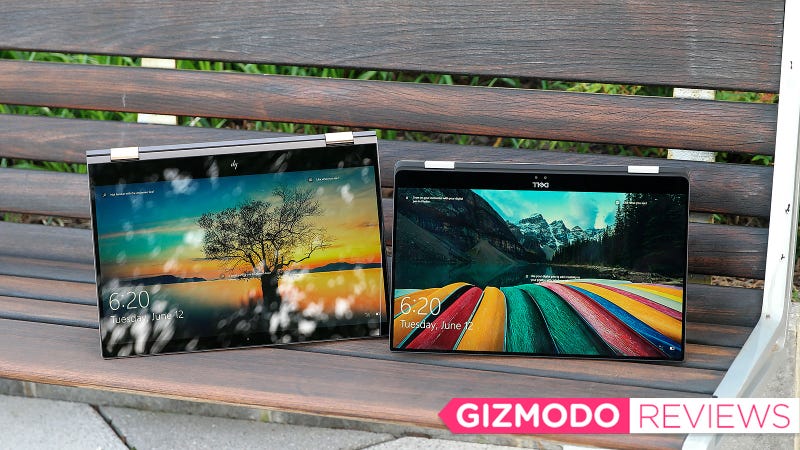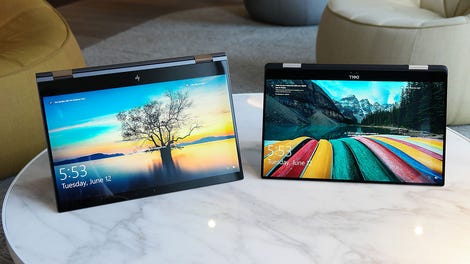 Photo: Sam Rutherford (Gizmodo)
Photo: Sam Rutherford (Gizmodo)
Even though they don’t look much different than a lot of other hybrid laptops, the release of the Dell’s XPS 15 2-in-1 and HP’s Spectre x360 15 is an important moment for today’s convertible PCs. That’s because by putting powerful, but not exceedingly expensive GPUs inside already flexible machines, it feels like 2-in-1s are finally ready to deliver on what made the idea of convertible computers so exciting in the first place.
Ever since I got my first laptop back in the mid-2000’s, I’ve been on a quest for a mobile computer that can do a bit of everything. Back then, most college kids already had laptops, but due to the power-hungry components they had (which were often crudely adapted from desktop parts), any laptop that weighed less than eight pounds was almost entirely relegated to just word processing and browsing the web.
That didn’t stop me from trying though, which led me to the purchase of an Alienware M5500 sporting discrete Nvidia graphics, adjustable colored lighting, and enough performance to play games on the go. That is, until its power supply and motherboard died barely a year after I got it, when it was conveniently just out of warranty. So then I got a Dell XPS M1710 (back before Dell bought Alienware and XPS was for Dell’s tag for gaming machines), which lasted longer longer at around 18 months before multiple dead GPUs and constant overheating issues knocked that system out of commission too. After that, I decided stability was more important than portability, so I reluctantly moved back to a desktop, but in the back of my head, the goal of finding a truly multipurpose laptop never died.
Laptops2-in-1s Laptops2-in-1s
Laptops2-in-1s
Dell XPS 15 2-in-1/HP Spectre x360 15
Laptops2-in-1s
Dell XPS 15 2-in-1/HP Spectre x360 15
Dell XPS 15 2-in-1/HP Spectre x360 15
What are they?
Premium 15-inch 2-in-1s with real GPUs
Price
Between $1,400 and $1,500 as tested
Like
These 2-in-1s are good at almost everything
Don't Like
The Dell’s webcam is in the wrong place; the HP has big bezels and its screen isn’t as bright
Then smartphones happened, which made touchscreens a thing people wanted on laptops too. And next came the first-gen Surface, a device that invented a whole new category of convertible laptops we now call 2-in-1s, which over the last few years has become the fastest growing segment in the laptop market. That brings us to now, when you can hardly shop for a laptop without being bombarded by a bevy of hybrid notebooks sporting built-in stylus support, touch displays, and potent CPUs that don’t require the strength and stupidity of youth just to carry around.
Modern 2-in-1s are exactly the kind of machine I’ve been searching for all these years, except that they still weren’t economical. That’s because systems like a 13-inch Surface Book 2 with a real GPU cost around $2,000, while the 15-inch model, which is what you really want for editing media or playing games on the side is priced even higher at around $2,5000 or more. But at CES 2018, HP and Dell announced the Spectre x360 15 and the XPS 15 2-in-1 featuring 8th-gen Intel Core i CPUs and AMD Radeon RX Vega M Graphics for under $1,500.
And after a couple weeks of using them both, I can say with confidence these convertibles are the real deal. Instead of falling into the trap of simply being jacks-of-all-trades, these two hybrids aren’t just okay at doing various things, they can do almost anything quite well. Both feature sturdy, 360-degree hinges, full Windows Ink support, and webcams that work with Windows Hello.
But what impresses me the most is the performance you get from that AMD RX Vega M GPU. To really get a sense of things, I compared a Dell XPS 15 2-in-1 featuring that aforementioned AMD graphics options to an HP Spectre x360 with Nvidia MX 150 graphics, which is the most powerful GPU you normally find in a 2-in-1.
And as you’d expect, the difference in the two’s performance is quite drastic. On both Civilization 6 (42.6 fps vs 12.7 fps) and Rise of the Tomb Raider (52.6 fps vs 24.7 fps) on high settings, the XPS 15 2-in-1 and its Vega M GPU posted frame rates that were two to three times higher than the MX 150-equipped Spectre x360. It was the same story in Overwatch too, where the XPS 15 2-in-1 hit 140 fps on high, as opposed to just 61 for the Spectre x360 15.
Of course, the Spectre can be equipped with the same AMD Vega GPU (and the Dell can be had with MX 150 graphics as well), but getting a chance to compare the two different GPUs really highlights how much better performance you get can just by spending an extra $120. Now, compare those numbers to the 54 fps in Civ 6 and 62.9 fps in Rise of the Tomb Raider we got from an Nvidia 1060-equipped Surface Book 2 we tested last year, and you can see why this latest generation of all-purpose convertibles are so exciting. For $1,000 more, the Surface Book 2 offers frame rates just 15 percent better than XPS 15 2-in-1 and its AMD Vega M chip.
On top of that, both systems achieved admirable battery life, with the XPS 15 2-in-1 lasting 8 hours and 28 minutes on our rundown test, while the Spectre x360 15 did even better at 9:14. Those are solid run times for any 15-inch laptop, let alone ones with real GPUs, and despite being significantly larger than both, the Surface Book 2 only outlasted the Spectre x360 15 by 50 minutes.
However, despite both systems sporting brushed aluminum outsides, when it comes to their overall design, that’s where Dell’s and HP’s strategies begin to differ. While the XPS 15 2-in-1 goes straight for all-out sleekness with a body that’s thinner, a quarter pound lighter and half an inch narrower than the Spectre x360 15, HP uses the Spectre’s larger body to make room for both types of USB ports (two Type-C and one Type-A), HDMI, a full SD card reader and even a side-mounted fingerprint sensor.
Meanwhile the XPS 15 2-in-1 has to make do with a microSD and three USB-C ports. That means owning the XPS 15 will almost certainly require carrying around a dongle from time to time, so I guess it’s nice that at least Dell tosses one USB-A to USB-C adapter in the box for free. (Note: The XPS 15 2-in-1 also has a fingerprint reader built into its power button, but its an optional extra.)
When viewed together, the Spectre’s bezels look huge, and at max brightness, the XPS’ 1080p panel puts out about 15 percent more light than Spectre’s 4K display. Photo: Sam Rutherford (Gizmodo)
On the inside, Dell’s quest for portability also results in some pretty drastic differences. When viewed side-by-side, the Spectre x360 15’s top and bottom bezels seem monstrous compared to the XPS. On the flipside, because of the XPS’ thin bezels, it also suffers from an awkward webcam that’s located below the screen. Even the XPS’ keyboard is shallower, with travel of just 0.7mm thanks to a new keyboard that uses magnets to provide tactile feedback instead of the traditional scissors switches found on the Spectre x360.
Having less key travel isn’t necessarily a bad thing, and the XPS’ keys don’t feel nearly as stiff as a modern day MacBook, but for people seeking a more comfortable typing experience, the Spectre comes out ahead. And once again, HP uses that extra space to cram in another feature the XPS doesn’t have: a numpad. The one wrinkle to all this is that despite being super wide, the Spectre x360 15’s touchpad feels restrictive because it’s not quite tall enough, a side effect that the XPS 15 2-in-1’s more square touchpad manages to avoid.
If you really care about portability, the XPS 15 2-in-1 is noticeably smaller and lighter. Photo: Sam Rutherford (Gizmodo)
In the end, for people who are constantly going to be on the move, the XPS 15 2-in-1’s smaller size, brighter screen and thinner bezels makes Dell’s hybrid the better choice. But for everyone else, the Spectre’s better connectivity, slightly better battery life, and more cushy keys gives the x360 15 the slightest of edges. Not to mention HP gives the Spectre a 4K display as standard, and when equipped with similar specs, it’s also about $100 cheaper. And frankly, especially in HP’s signature copper and charcoal paint job (which the company inexplicably calls Ash Silver), I think the Spectre looks better too.
But make no mistake, whichever one you choose, Dell and HP’s new 2-in-1s aren’t like the weaker, limited convertibles that came before. These machines can play games, edit videos, and do pretty much anything else you want or need for $1,500, without having any major weaknesses either. If I was forced to use just one computer for the next year, it would be one of these, which even for a long-standing 2-in-1 aficionado like me, is not something I’ve been really comfortable saying until now.
README
- AMD’s Radeon RX Vega M GPU offers twice the graphics performance of an Nvidia MX 150 with a relatively minor impact on battery life.
- The ideal config that balances prices and performance is an Intel Core i5 CPU, 8GB of RAM, 256GB SSD, and a Radeon RX Vega M GPU.
- The XPS 15 2-in-1 is the better option for mobility thanks to its smaller dimensions, brighter screen, and a slightly lighter weight, but its webcam is in an awkward location.
- The HP Spectre x360 is features a wider selection of ports, a 4K touchscreen standard, better speakers, side-mounted fingerprint reader and slightly longer battery life, but it’s also a tad bit bulkier.
- Both systems can be a bit cumbersome when used as a tablet, but that’s mostly due to the size of their screens.